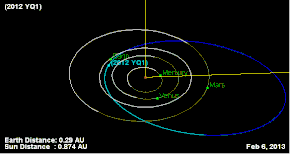 Orbit (blue) of asteroid 2012 YQ1 for 6 February 2013 Orbit (blue) of asteroid 2012 YQ1 for 6 February 2013 | |
| Discovery | |
|---|---|
| Discovered by | A. Oreshko T. Kryachko |
| Discovery site | Elena Remote Obs. |
| Discovery date | 19 December 2012 (first observed only) |
| Designations | |
| MPC designation | 2012 YQ1 |
| Minor planet category | NEO · Apollo · PHA |
| Orbital characteristics | |
| Epoch 13 January 2016 (JD 2457400.5) | |
| Uncertainty parameter 6 | |
| Aphelion | 3.11880 AU (466.566 Gm) |
| Perihelion | 0.86916 AU (130.024 Gm) |
| Semi-major axis | 1.99398 AU (298.295 Gm) |
| Eccentricity | 0.56411 |
| Orbital period (sidereal) | 2.82 yr (1028.4 d) |
| Mean anomaly | 12.74578° |
| Mean motion | 0° 21 0.158 /day |
| Inclination | 5.15193° |
| Longitude of ascending node | 120.16813° |
| Argument of perihelion | 42.09537° |
| Earth MOID | 0.00774939 AU (1,159,292 km) |
| Physical characteristics | |
| Mean diameter | ~220 m (720 ft) |
| Absolute magnitude (H) | 21.1 · 20.9 |
(669555) 2012 YQ1 is a sub-kilometer asteroid, classified as a near-Earth object and a potentially hazardous asteroid of the Apollo group, approximately 200 meters in diameter. It was first observed on 19 December 2012, by astronomers Andrey Oreshko and Timur Kryachko at the Elena Remote Observatory (G32) located in the Chilean Atacama desert.
Description
With a 4-day observation arc, the asteroid had a 1 in 3 million chance of impacting in 2106. With a 10-day observation arc, the asteroid had a 1 in 10 million chance of impacting in 2106. On 5 January 2013, the asteroid passed 0.10 AU (15,000,000 km; 9,300,000 mi) from Earth. It was removed from the Sentry Risk Table on 8 January 2013. It had an observation arc of 32 days and an orbital uncertainty of 7. Since the asteroid had a poorly known orbit, the cone of uncertainty quickly multiplied as a result of perturbations by the inner planets and prevented precise/reliable ephemeris data. Eliminating an entry on the Sentry Risk Table is a negative prediction; a prediction of where it will NOT be. With MPEC 2024-C131 the Minor Planet Center published a newly computed orbit on 12 February 2024, using observations till 12 November 2023 and prediscovery observations from 31 May till 5 June 2010, reducing the uncertainty to 1.
In the popular press
In 2013, an article, originally posted on The Voice of Russia had a poorly researched headline stating "We have 93 years left till the next End of the World". This story was reposted on Space Daily, but then astronomer Phil Plait clarified that it was "a fascinating mix of fact and error. A lot of what it says is accurate, but the most important claim—that an asteroid will impact Earth in 2106—is simply wrong."

See also
References
- ^ "MPEC 2012-Y15 : 2012 YQ1". IAU Minor Planet Center. 21 December 2012. Retrieved 5 February 2013. (K12Y01Q)
- ^ "2012 YQ1". Minor Planet Center. Retrieved 7 February 2018.
- ^ "JPL Small-Body Database Browser: (2012 YQ1)" (2013-07-04 last obs.). Jet Propulsion Laboratory. Retrieved 7 February 2018.
- ^ "Observations of small Solar-System bodies". HohmannTransfer. 24 December 2012. Retrieved 6 February 2013. (3.3e-07 = 1 in 3,030,000 chance)
- ^ "Observations of small Solar-System bodies". HohmannTransfer. 30 December 2012. Retrieved 5 February 2013.
- "Date/Time Removed". NASA/JPL Near-Earth Object Program Office. Archived from the original on 2 June 2002. Retrieved 19 March 2012.
- Zamanskaya, Yulia (8 February 2013). "We have 93 years left till the next End of the World: killer asteroid to hit Earth in 2106: Voice of Russia". english.ruvr.ru. Archived from the original on 8 February 2013. Retrieved 8 October 2023.
- ^ Phil Plait (13 February 2013). "No, An Asteroid Is NOT Going to Hit Earth in 2106". Slate.
External links
- (669555) 2012 YQ1 at NeoDyS-2, Near Earth Objects—Dynamic Site
- (669555) 2012 YQ1 at ESA–space situational awareness
- (669555) 2012 YQ1 at the JPL Small-Body Database
| 2013 in space | ||||||
|---|---|---|---|---|---|---|
| Space probe launches |
|    | ||||
| Impact events | ||||||
| Selected NEOs | ||||||
| Exoplanets |
| |||||
| Discoveries |
| |||||
| Novae | ||||||
| Comets | ||||||
| Space exploration |
| |||||
| Minor planets navigator | |
|---|---|
| Small Solar System bodies | |||||||
|---|---|---|---|---|---|---|---|
| Minor planets |
| ||||||
| Comets | |||||||
| Other | |||||||